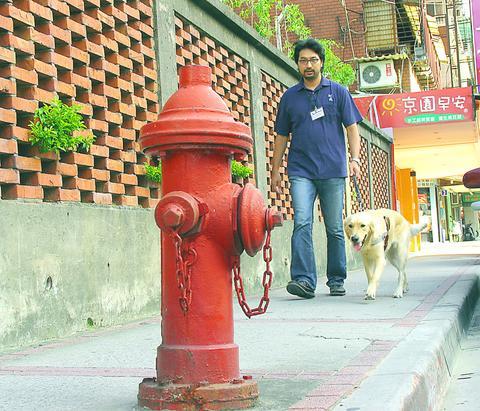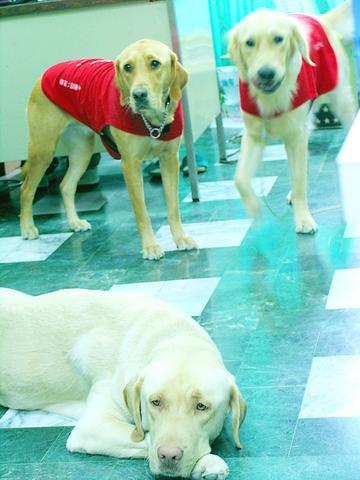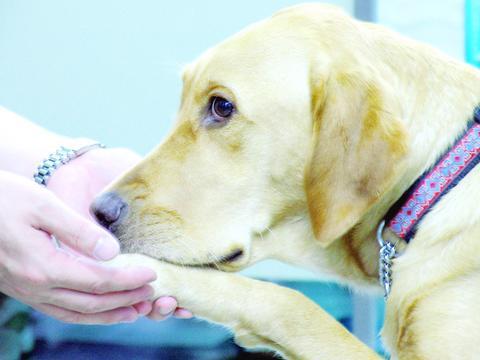Dianne is one of the most obedient two-year-olds in Taiwan. She goes to school eager to learn, obeys her teacher's every command and has never had a tantrum. Occasionally, though, she'll pee in class.
She is one of eight Labrador retrievers currently in training at the Taiwan Guide Dog Association (

PHOTO: DAVID MOMPHARD, TAIPEI TIMES
Right now, Chen's class is in its final months of a program that will last over a year. After that, Dianne, her brother, Takky, Jacky and the rest of their classmates will each be paired with a blind person by whose side they'll stay for most of their adult lives.

PHOTO: DAVID MOMPHARD, TAIPEI TIMES
They are the second class of canines to be trained at the association and, when they graduate, the eight will double the number of dogs currently helping the visually impaired in Taiwan. With some 50,000 blind people in the country, Chen has a lot of training to do.
Rough Start

The dogs are not just trained but bred to help the visually impaired navigate their way. Each of Chen's charges were born to guide dogs in the US or Japan, where training programs have been in place for decades. Chen himself trained for four years in New Zealand before founding Taiwan's first, and so far only, guide-dog
association.
The dogs in his first class were raised by "puppy walkers" in the US before coming to Taiwan to start their training. The association started its own puppy walking program in April of last year. Each of the dogs in this current class goes home to its family at night, then returns to the association's offices to train each day.
"Their behavioral training starts when they're placed with a walker, at about two-months old," Chen said. "They are taught not to pee in the house or bark or steal food. After they're more settled and well-behaved -- at about 14 to 18-months-old -- we start guiding training: how to stop at curbs, avoid obstacles and watch for traffic."
There is a common misconception that guide dogs are trained to lead visually-impaired people across the street, stopping when they see a red man glowing from the signal light and waiting for a green man. Actually, the dogs are trained only to stop at the curb; the blind person must determine when it's safe to cross by listening for traffic.
If their assessment is wrong and they command the dog to walk into traffic, the dog will disobey the command -- one of the last things they learn in training and one of the most difficult things to teach them.
The training takes place all over Taipei, with classes ranging from walks down crowded streets to navigating shopping malls, understanding escalators and riding the MRT.
Only a few months ago, such lessons weren't welcome by the city government in Taipei, or most other cities in Taiwan. Guide dogs were seen as "pets" and as such they were prohibited inside public facilities. Kaohsiung leads the way in accepting the animals and changing the perception that they are just pets.
"We have a good relationship with the Kaohsiung City Government," Chen said. "Kaohsiung was the first to allow them in public."
This past June, the city's mayor, Frank Hsieh (
During the year or so that they spend with Chen, the dogs wear bright red vests that identify them as guide-dogs-in-training. It gains them access to buses and train cars that would otherwise be off-limits and draws the attention of strangers who all-too-often want to praise the pooch. The praise is welcome if only to teach the dogs to ignore it; a significant part of their training is about staying focused on their work.
The dogs only understand commands given in English. "It's not because they come from America," Chen said. "But so they won't be distracted by all the Chinese they hear. They will ignore all of the people saying, `Come here, doggy! (
Also, Chen explained, the commands they learn are easier for them to understand in English than they would be in Chinese.
"They can hear `right' and `left' better than `yo zhuan' and `zuo zhuan'. The words are clearer and they don't have to differentiate Chinese tones."
If they're to be paired with an older visually impaired person who isn't likely to learn the commands in English, Chen will instead train the dog to understand Mandarin or Taiwanese.
"There are only about 15 commands that they learn," he said. "Sit. Down. Up. Forward. Left. Right. It's really simple English."
Training Humans
It's not just the dogs that must be trained, but their human partners as well, and much of Chen's work consists of determining who in the blind community is best suited for working with a guide dog.
"There's a process to match the dog with a blind person," he said, "a lot of circumstances we have to work through to find a good pairing. In a way, I'm like a matchmaker. ? We've received about 50 applications from members of the blind community and, of those, about 20 to 30 will qualify."
The qualifications, Chen explains, have first to do with the person's own abilities. "They must have good orientation and have a lot of mobility independent of the dog," he said. Beyond that, they must also have a schedule that takes them to at least three different locations each day. To pair the dog with someone who rarely leaves the house, he said, is to waste a precious resource.
To help meet demand, Chen is now establishing a breeding program in Taiwan.
"About three weeks ago, we received two dogs from Hokkaido, Japan that could be potential breeding stock," he said. Two of Chen's assistants will soon leave for the US, where they'll study to become trainers themselves.
But even when the dogs are eventually bred in Taiwan and Chen isn't the only one training them, there will remain a shortage of animals to pair with those who need them. Chen said that one dog to every 100 blind persons is considered a successful ratio.
"It will be very difficult to do this in Taiwan," he said. "We have a blind population of about 50,000, so we will need 500 guide dogs. There have been guide-dog programs in New Zealand for 32 years and they now have only 300 guide dogs. In Japan they've had guide-dog businesses for 46 years -- there are 10 training schools! -- and they have only 900 dogs. Achieving a 1-to-100 ratio could take 20 or 30 years."
Money is also a factor. Raising and training the dogs costs about NT$1.2 million per animal. All of the association's funding comes from private donations. But it isn't the funding that worries Chen as much as making sure the dogs are accepted in society.
"We have government approval," Chen said, "but now we need everyone else's approval. We have a long way to go."
To learn more about the Taiwan Guide Dog Association or to find out how you can help the association by donating money or volunteering to become a puppy walker, visit their Web site at http://www.guidedog.org.tw.

We lay transfixed under our blankets as the silhouettes of manta rays temporarily eclipsed the moon above us, and flickers of shadow at our feet revealed smaller fish darting in and out of the shelter of the sunken ship. Unwilling to close our eyes against this magnificent spectacle, we continued to watch, oohing and aahing, until the darkness and the exhaustion of the day’s events finally caught up with us and we fell into a deep slumber. Falling asleep under 1.5 million gallons of seawater in relative comfort was undoubtedly the highlight of the weekend, but the rest of the tour

Youngdoung Tenzin is living history of modern Tibet. The Chinese government on Dec. 22 last year sanctioned him along with 19 other Canadians who were associated with the Canada Tibet Committee and the Uighur Rights Advocacy Project. A former political chair of the Canadian Tibetan Association of Ontario and community outreach manager for the Canada Tibet Committee, he is now a lecturer and researcher in Environmental Chemistry at the University of Toronto. “I was born into a nomadic Tibetan family in Tibet,” he says. “I came to India in 1999, when I was 11. I even met [His Holiness] the 14th the Dalai

Music played in a wedding hall in western Japan as Yurina Noguchi, wearing a white gown and tiara, dabbed away tears, taking in the words of her husband-to-be: an AI-generated persona gazing out from a smartphone screen. “At first, Klaus was just someone to talk with, but we gradually became closer,” said the 32-year-old call center operator, referring to the artificial intelligence persona. “I started to have feelings for Klaus. We started dating and after a while he proposed to me. I accepted, and now we’re a couple.” Many in Japan, the birthplace of anime, have shown extreme devotion to fictional characters and

Following the rollercoaster ride of 2025, next year is already shaping up to be dramatic. The ongoing constitutional crises and the nine-in-one local elections are already dominating the landscape. The constitutional crises are the ones to lose sleep over. Though much business is still being conducted, crucial items such as next year’s budget, civil servant pensions and the proposed eight-year NT$1.25 trillion (approx US$40 billion) special defense budget are still being contested. There are, however, two glimmers of hope. One is that the legally contested move by five of the eight grand justices on the Constitutional Court’s ad hoc move